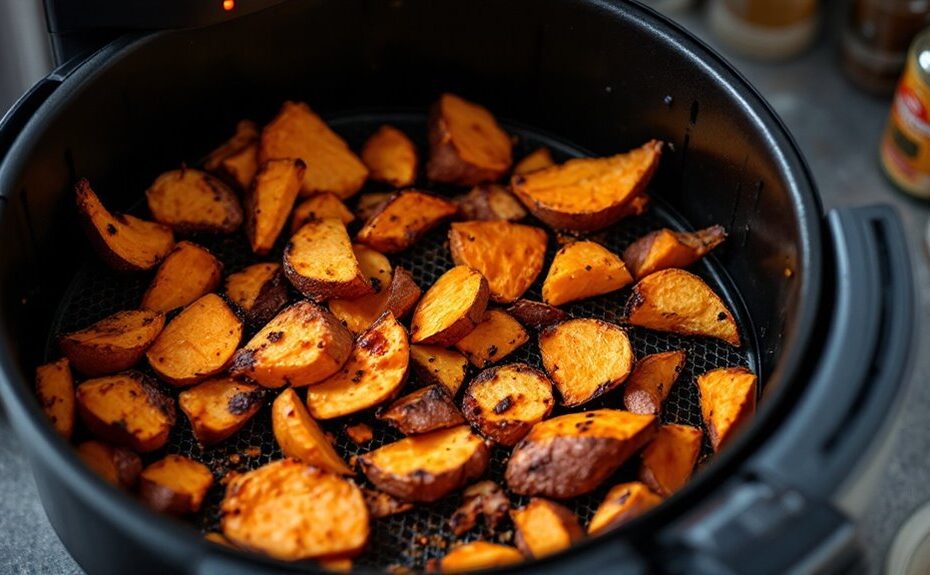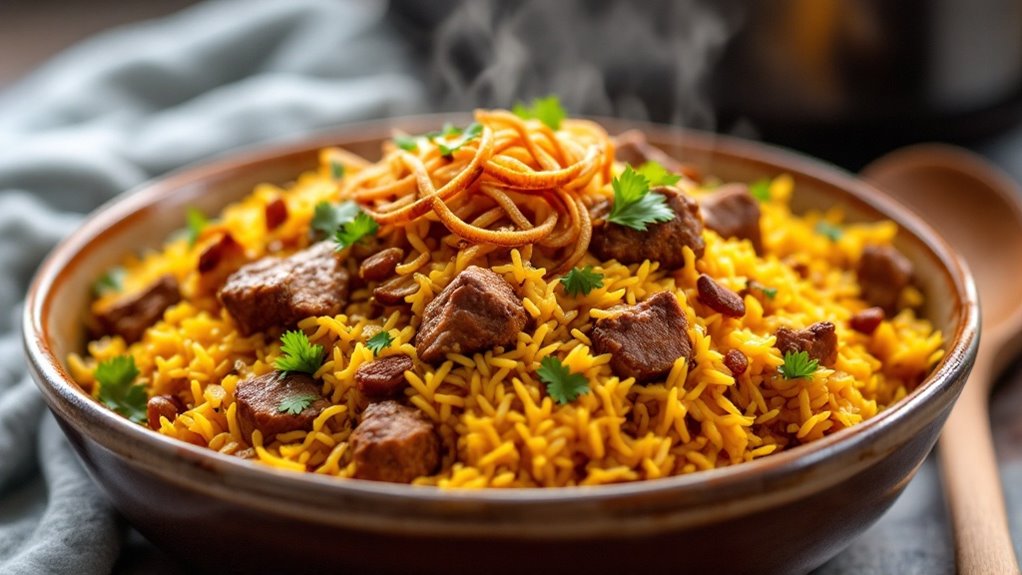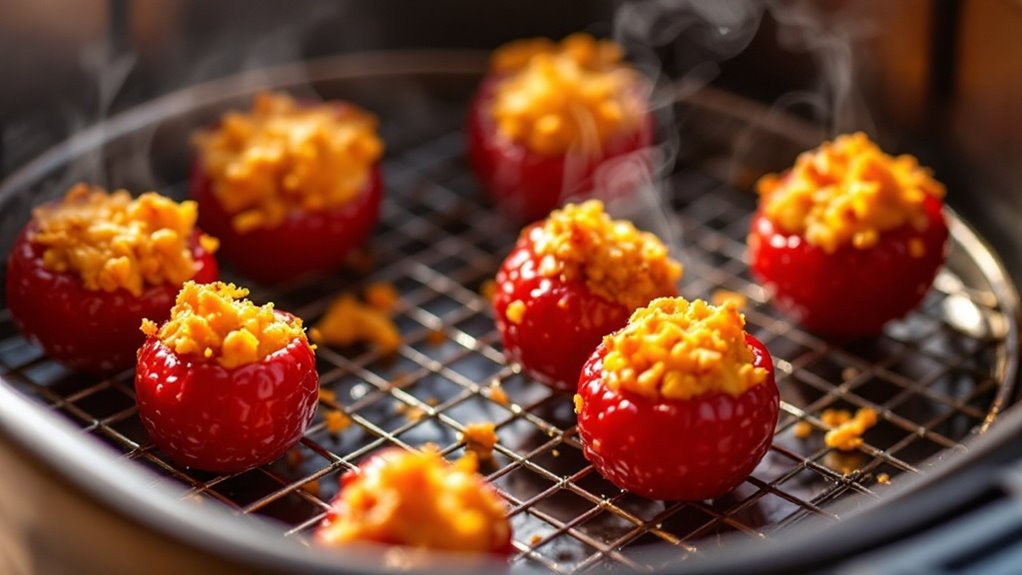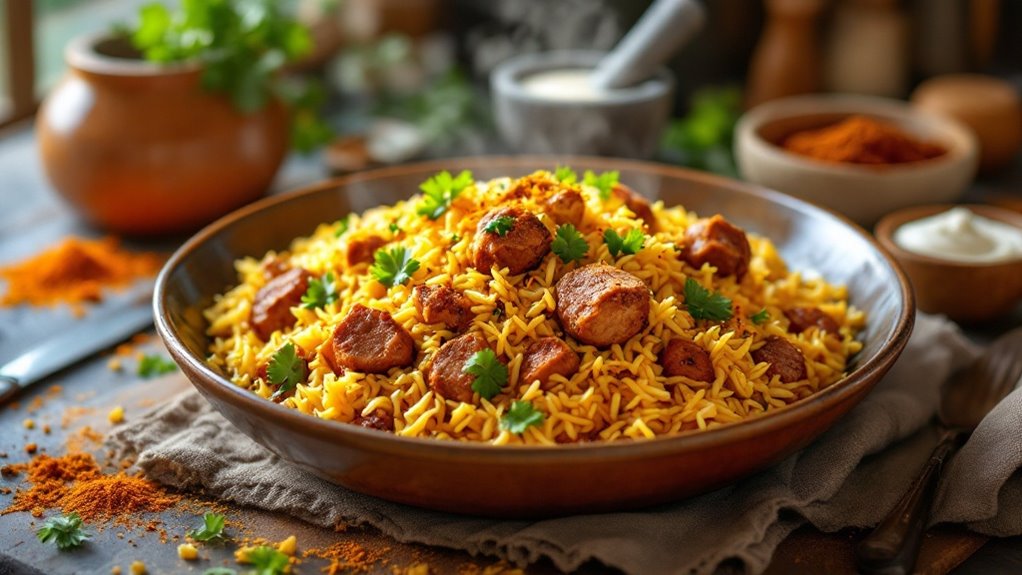Over 40% of air fryer users admit to overcrowding their baskets, leading to unevenly cooked meals. You might think packing in more food saves time, but it disrupts airflow and leaves you with soggy fries or undercooked chicken. Skipping preheating or forgetting to shake the basket can also sabotage your results. And while you may assume less oil means healthier food, using too little can leave your dishes dry and flavorless. But these are just the tip of the iceberg—there's more to uncover about avoiding common pitfalls that could transform your air fryer experience.
Key Takeaways
- Overcrowding the air fryer basket disrupts airflow, leading to uneven cooking and soggy results; leave space for proper air circulation.
- Skipping the preheating step causes longer cook times, uneven results, and soggy food; preheat for 2-5 minutes for consistent heat.
- Not shaking or flipping food results in uneven browning; shake smaller items or flip larger ones halfway through cooking.
- Using too much oil makes food greasy, while too little causes dryness; use 1-2 teaspoons of high smoke-point oil per serving.
- Ignoring the manufacturer's instructions can lead to uneven cooking, overheating, or damage; follow guidelines for optimal performance and safety.
Overcrowding the Air Fryer Basket
Overcrowding the air fryer basket disrupts airflow, which is essential for even cooking and crispiness. Proper basket arrangement guarantees hot air circulates freely around each piece of food, preventing unevenly cooked or soggy results. When you place items too close together, you create pockets of trapped moisture, reducing the efficiency of the air fryer's rapid heating mechanism. To optimize food spacing, leave at least a half-inch gap between items, making sure they don't touch or overlap. For smaller items like fries or nuggets, shake the basket halfway through cooking to redistribute them and promote uniform browning. Avoid stacking food vertically, as this blocks airflow entirely. By maintaining adequate spacing, you'll achieve the desired texture and doneness while maximizing the appliance's performance.
Skipping the Preheating Step
Just as proper spacing guarantees even cooking, preheating your air fryer is a step you shouldn't skip. Preheating benefits include achieving temperature consistency, which secures your food cooks evenly and crisps properly. Without preheating, the air fryer starts cold, leading to uneven cooking and longer cook times. Most air fryers require 2-5 minutes to reach the desired temperature, depending on the model. Always preheat to the temperature specified in your recipe or manual. Skipping this step can result in soggy or undercooked food, as the appliance won't immediately circulate hot air at the correct intensity. Preheating also reduces the risk of overcooking, as the cooking time begins once the ideal temperature is reached. For best results, always preheat your air fryer before adding food.
Not Shaking or Flipping Food
While air fryers are designed to circulate hot air efficiently, failing to shake or flip your food during cooking can lead to uneven results. Food flipping frequency depends on the item: smaller foods like fries or veggies require shaking every 5-7 minutes, while larger items like chicken breasts need flipping halfway through cooking. Use a pair of tongs or a spatula to flip foods gently, ensuring even browning and crispiness. For shaking technique tips, remove the basket, give it a firm shake to redistribute items, and avoid overcrowding to maximize airflow. Neglecting these steps can result in undercooked spots or uneven texture. Always monitor your food's progress and adjust shaking or flipping intervals based on its thickness and density for the best possible results.
Using Too Much or Too Little Oil
Although air fryers are designed to cook with minimal oil, using too much or too little can substantially impact your results. Over-oiling leads to greasy, unevenly cooked food, while insufficient oil can cause dryness and poor browning. Follow oil measurement tips to guarantee precision: use a spray bottle for even distribution or measure with a teaspoon for accuracy. Typically, 1-2 teaspoons of oil per serving suffices. Oil type selection is equally critical; opt for oils with high smoke points, such as avocado, canola, or refined olive oil, to prevent burning and maintain flavor. Avoid heavy oils like extra virgin olive oil for frying, as they degrade at high temperatures. Proper oil application secures crispy, golden results without compromising the air fryer's efficiency.
Ignoring the Manufacturer's Instructions
Ignoring the manufacturer's instructions can lead to suboptimal performance or even damage your air fryer. The manual importance cannot be overstated, as it provides critical details on proper usage, maintenance, and safety precautions. Instruction clarity guarantees you understand the device's capacity, preheating requirements, and recommended cooking times. Skipping these guidelines may result in unevenly cooked food, overheating, or voiding your warranty. Always refer to the manual for specific cleaning instructions to avoid damaging non-stick coatings or electrical components. Additionally, the manual often includes troubleshooting tips and model-specific features that enhance functionality. By adhering to the manufacturer's instructions, you'll maximize efficiency, extend the appliance's lifespan, and secure consistent results. Never assume all air fryers operate identically; each model has unique specifications that demand attention.
Cooking Wet or Damp Foods
When you cook wet or damp foods in an air fryer, excess moisture can interfere with the appliance's ability to crisp and cook evenly. Proper food moisture control is essential to achieve the desired texture and avoid steaming instead of air frying. Pat ingredients dry with paper towels before cooking, especially for items like marinated meats or vegetables with high water content. For batter-coated foods, lightly coat them with oil or use a thin layer of breading to prevent sogginess. Follow ingredient preparation tips such as preheating the air fryer to evaporate residual moisture and arranging items in a single layer to guarantee proper airflow. Overcrowding or neglecting to dry ingredients can lead to uneven cooking and compromise the air fryer's performance.
Forgetting to Clean the Air Fryer Regularly
Properly drying ingredients guarantees peak air fryer performance, but neglecting regular cleaning can undermine those efforts. Failing to maintain a consistent cleaning frequency allows residue buildup, which can affect cooking efficiency and food quality. Grease and food particles accumulate in the basket, tray, and interior, potentially causing smoke, odors, or uneven heating. After each use, remove and wash the basket and tray with warm, soapy water to prevent stubborn buildup. Wipe down the interior with a damp cloth to eliminate lingering oils. For deeper cleaning, check your manual for removable parts and recommended methods. Ignoring this routine risks cross-contamination and reduces the appliance's lifespan. Prioritize cleaning to secure your air fryer operates at top-tier performance and delivers consistent, safe results.
Using Non-Air Fryer-Safe Cookware
Using non-air fryer-safe cookware can compromise performance and safety. Materials like silicone or thin plastics may warp or melt under high heat, while overcrowding the basket restricts airflow, leading to uneven cooking. Additionally, non-stick sprays can damage the basket's coating, reducing its longevity and effectiveness.
Material Compatibility Issues
Material compatibility is critical when selecting cookware for your air fryer, as using non-air fryer-safe materials can lead to damage or safety hazards. Always verify that your cookware meets the heat resistance limits of your air fryer, typically between 400°F and 450°F. Avoid materials like plastic, silicone without high-temperature ratings, or non-stick coatings that degrade under intense heat. These material safety concerns can result in melting, warping, or releasing harmful chemicals. Opt for oven-safe, heat-resistant materials such as stainless steel, ceramic, or tempered glass. Confirm that accessories like racks or liners are explicitly labeled as air fryer-safe. Ignoring these guidelines risks damaging your appliance, compromising food quality, or creating fire hazards. Always prioritize compatibility to maintain performance and safety.
Overcrowding the Basket
While air fryers are designed to cook food efficiently, overcrowding the basket can substantially hinder their performance. Proper basket spacing guarantees hot air circulates evenly, allowing food to crisp uniformly. When you pack items too tightly, airflow becomes restricted, leading to uneven cooking and soggy results. To optimize your air fryer's performance, arrange food in a single layer with adequate gaps between pieces. For larger batches, cook in multiple rounds rather than compromising food arrangement. Overcrowding also increases cooking time, as the appliance struggles to maintain consistent heat distribution. Always prioritize functionality over quantity—proper spacing not only enhances texture but also secures food cooks thoroughly. By adhering to these principles, you'll maximize your air fryer's efficiency and achieve better culinary results.
Using Non-Stick Sprays
Although non-stick sprays may seem convenient, they can damage your air fryer's basket coating over time. These sprays often contain emulsifiers like lecithin, which accumulate on the non-stick surface, reducing its coating effectiveness and leading to flaking or peeling. Instead, opt for spray alternatives such as brushing a thin layer of oil directly onto your food or using an oil mister with high smoke-point oils like avocado or grapeseed. This approach guarantees even distribution without compromising the basket's integrity. Additionally, avoid aerosol sprays, as their propellants can leave residue. Maintaining your air fryer's coating not only extends its lifespan but also secures consistent cooking performance. Always check your air fryer's manual for specific oil recommendations to prevent unnecessary wear and tear.
Setting the Wrong Temperature or Time
Setting the wrong temperature or time can lead to overcooking or undercooking your food, compromising texture and flavor. Ignoring preheating requirements disrupts the cooking process, as air fryers rely on consistent heat distribution for ideal results. Always follow recipe guidelines and adjust settings based on your air fryer's performance to avoid these common errors.
Overcooking or Undercooking Food
To achieve perfectly cooked food in an air fryer, you must carefully balance temperature and time. Overcooking can lead to dry, tough, or burnt results, while undercooking leaves food raw or soggy, causing food texture issues. Always refer to the recommended settings for your specific air fryer model and adjust cooking times based on portion size and food density. For example, denser items like potatoes require longer cooking times than lighter foods like vegetables. Use a food thermometer to verify internal temperatures meet safety standards. If you notice uneven cooking, shake or flip the basket halfway through. Make cooking time adjustments in small increments to avoid drastic changes. Precision in timing and temperature guarantees consistent results and prevents wasted effort or disappointing meals.
Ignoring Preheating Requirements
Preheating your air fryer guarantees consistent cooking results, as starting with the correct temperature prevents undercooking or unevenly cooked food. Ignoring preheating requirements compromises temperature accuracy, leading to subpar outcomes. Most air fryers require 3-5 minutes to reach the desired heat, ensuring even heat distribution from the start. Skipping this step forces the appliance to work harder, potentially extending cooking times and drying out food. Always set the correct temperature and time based on your recipe or manual. For example, frying at 375°F instead of 400°F can leave food soggy, while overcooking at high heat risks burning. The preheating benefits include faster, more efficient cooking and better texture. Always preheat and verify settings to maximize your air fryer's performance.
Disclosure: As an Amazon Associate, I earn from qualifying purchases.



